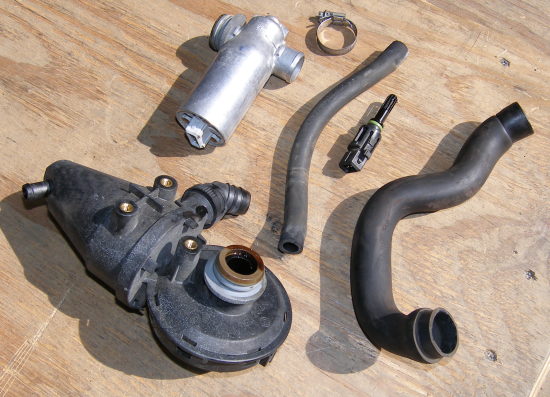Saturday, July 4, 2009
CCV and ICV Preventative Maintenance
Today I decided to install the new oil separator (also known as the crankcase vent, or CCV), idle control valve (ICV) and, while I was at it, an intake air temperature sensor. The CCV was the original part with nearly 180K miles and the ICV was a couple thousand miles over my recommended interval of 108K miles, so they were both ready for replacement in my opinion.
 I chose to do all of these parts at the same time because they share a lot
of required labor to disassemble the intake air ductwork. While the parts
were not cheap and some might question my sanity for replacing them in
advance of a failure (in other words, as preventative maintenance) the failure
modes for both the CCV and ICV are not pretty, so if I
avoid the cost and inconvenience of a tow (or better yet, in the case of the
CCV, engine damage) I'll consider it money very well spent. The intake air
temperature sensor was admittedly an impulse buy, but at $20 who could blame
me?
I chose to do all of these parts at the same time because they share a lot
of required labor to disassemble the intake air ductwork. While the parts
were not cheap and some might question my sanity for replacing them in
advance of a failure (in other words, as preventative maintenance) the failure
modes for both the CCV and ICV are not pretty, so if I
avoid the cost and inconvenience of a tow (or better yet, in the case of the
CCV, engine damage) I'll consider it money very well spent. The intake air
temperature sensor was admittedly an impulse buy, but at $20 who could blame
me?
The job was straightforward and involved the removal of the entire intake ductwork from the airbox to the intake manifold. Fortunately, the work did not require removal of the intake manifold as I was originally led to believe. I bought new, somewhat pricey, rubber gaskets for the intake manifold just in case and they went unused, but the DIY dividend of this job more than paid for those. I also bought extra screws and washers to attach the separator (which also work for the idle control valve mounting bracket, as it turns out) and did not wind up using those either, but they were inexpensive so I don't feel any great loss there.
After about 3 hours of work I had managed to swap all the parts, reassemble everything, double check that all electrical connectors and vacuum-related lines were secure, and then turn the key. I was greeted with an instantaneous start and a smooth idle. I found this to be a notable change from the "stumble starts" I've been getting lately, where the first few cylinders misfire before the engine breaks into a sustainable idle less than a second later. In the past I've attributed this to ethanol contamination of our gasoline combined with higher temperatures this time of year, but I must admit when I heard the engine fire up and idle not only more smoothly, but a good 150-200 RPM higher than it had as of late I began to wonder whether this may have been due to a sticky or otherwise ailing idle control valve. Only time will tell of course.
I could best describe this job by the same name attributed by my high school chemistry teacher to our first lab that involved cutting and bending glass over Bunsen burners -- "cuts and burns". As I write this my hands and arms have their share of scrapes and cuts. Fortunately, the DIY dividend on these tasks is significant so I'll gladly apply bandaids for a couple days and consider myself lucky. Book labor for the ICV and CCV is 2.0 hours EACH, and as long-time readers know dealers do not "combine" jobs or provide any kind of labor discount for individual jobs that share labor costs. And yes, that's unfair, but that's the way it is. I did not price the air temperature sensor labor but I can't imagine it being less than an hour. I could include that as well but since it wasn't a "primary target" I think I'll kindly ignore the sensor and remain comfortable with the fact that I saved another four hours of book labor at $128/hr, or $512 today.
Mileage: 179022, Parts: $376, Labor savings $512



